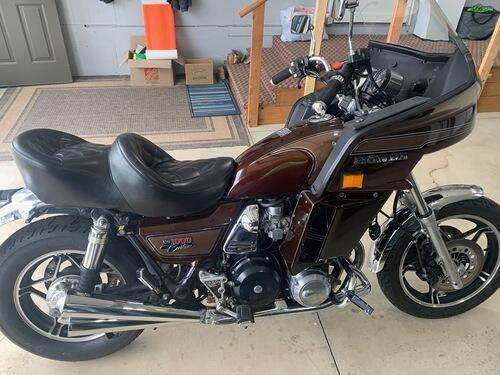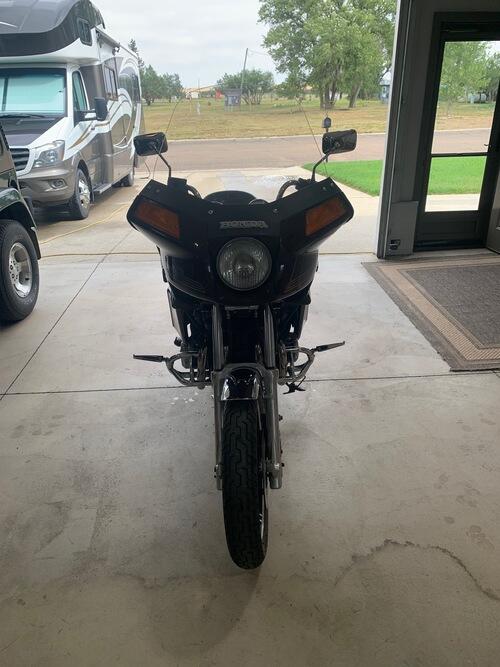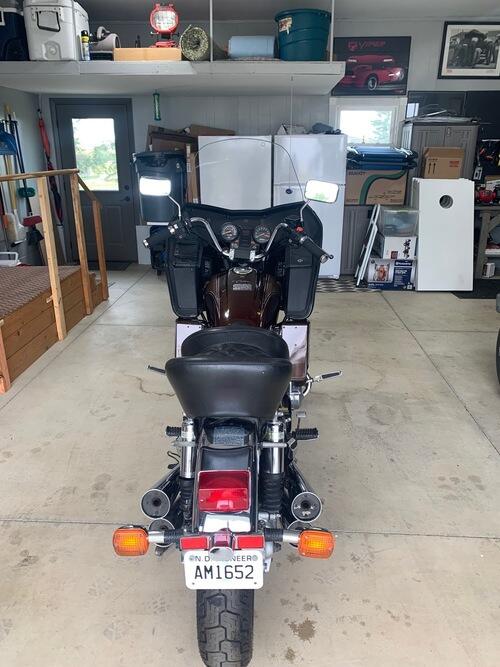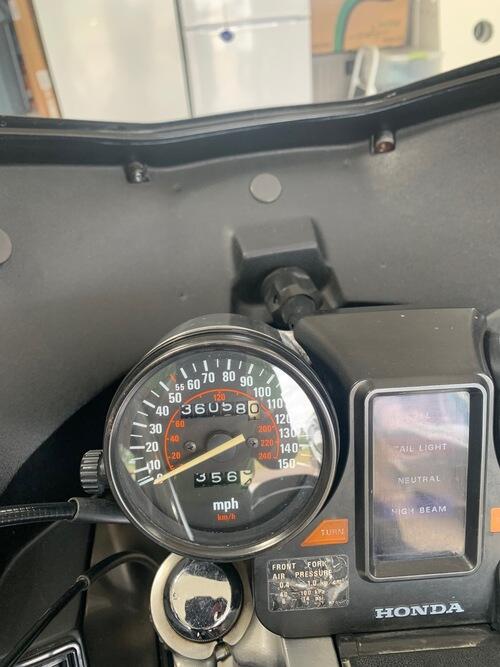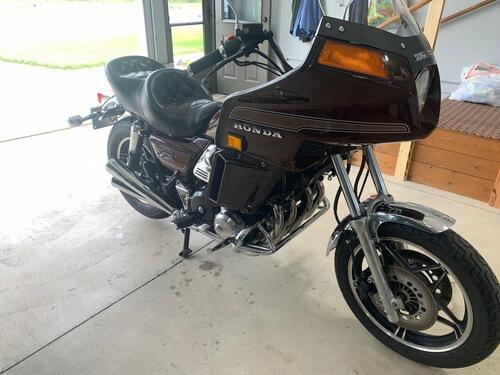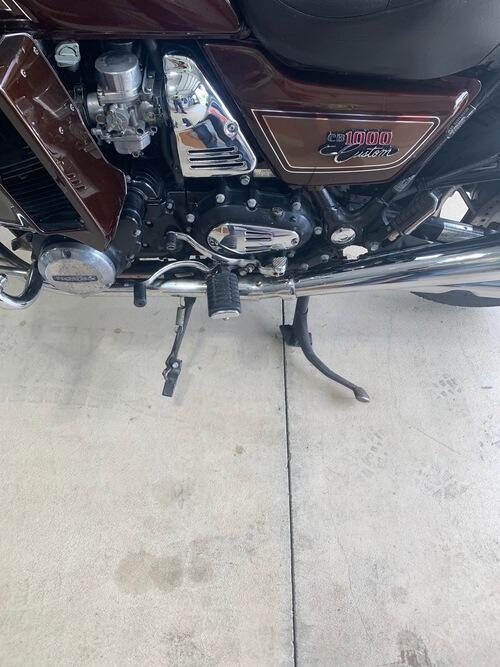Motorcycle Make
Year
- Ads
- My Ads
- Post an Ad
- Stats
- Saved Searches / My Feed
- Watch List
- Messages
- Messages
- Settings
- Mobile
- Billing Methods
- Facebook Linking
- Privacy
- Notifications
- Change Password
- Help & Support
- Help & Support Center
- Tips
- Rules & Policies
- User Agreement
- Privacy Policy
- Scam Info
- Contact Us
- Session
- Log Out
- More
- About Us
- Advertise With Us
- NorthWing Media
1983 Honda CB1000C - Would look great under the X-Mas Tree!
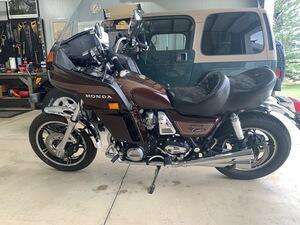
6 More Photos
1983 Honda CB1000C
Description:
Brown
Single year production
DOHC 4 cylinder with 4 carburetors
Shaft drive with 5 speed transmission and two-speed auxiliary transmission (effectively 10 forward gears)
Air adjustable suspension (still functional)
Dual front and single rear disc brakes
Electric start
Full frame mounted fairing with lowers (all in good shape)
Analog gauges (tachometer and speedometer)
Small luggage rack with seat cushion (original Honda accessory)
4 into 4 exhaust system (original)
Side and Center Stand
Recent work and new parts:
Rebuilt the carburetors
New tires front and rear (Dunlop)
Changed engine oil and filter (one oil filter and enough oil for one change included)
Changed transmission fluid
Changed rear drive fluid
Flushed out brake system (front and rear), replaced fluid and bled brakes
Cleaned cable housings (speedometer, tachometer, brake, clutch and throttle) and lubricated cables
Installed fuel filter with carburetor rebuild
New horns
New windshield
Adjusted valves
Adjusted cam drive chain
Synchronized carburetors
Replaced front brake pads (have rear pads in package)
New riding pegs
Aftermarket King/Queen seat (still have original)
Some flaws:
Discoloration on gas tank from fuel spill
Right side upper muffler has been repaired at connection to header pipe
Small dings, dents and scratches (it is 41 years old and has 36,000 miles on it)
May 1983 article in Cycle World:
Anywhere but a Honda dealership, the CB1000C would be a standout. There, it isnt as big as a Gold Wing, not as powerful as a CB1100F or V65, not as good handling as an Interceptor and not as new a design as almost any other bike in sight. The only reason it still exists is because its too good to go away.
It was 1979 when this engines immediate predecessor entered production in the twin cam CB750 series. A year later the CB900 Custom was introduced, and with it, the dual-range auxiliary transmission and shaft final drive. Now the CB900 has been turned into the CB1000 with larger pistons.
Through it all the inline, air-cooled, dohc Four has been refined. Bore and stroke are now 67mm by 69mm. This is the same stroke found on the old CB900 and the new CB1100F, but the bore sizes range from 64.5mm on the 900 up to 70mm on the 1100. Thats a lot of versatility from an engine that started life as a 750.
Much of this engines design is no longer unusual. The pair of cams in the head are more normal now, though the cam drive isnt. A link-plate chain runs between cylinders two and three to drive only the exhaust cam. A second link plate chain connects the exhaust and the intake cams. Bucket followers operate the four valves in every cylinder, and the pent roof combustion chamber allows room for large valves. Compression ratio is up to 9:1 from the 8.8:1 of the 900. This comes from changes in the combustion chamber and piston size. The larger pistons are held in stronger connecting rods, with 17mm wrist pins instead of the 15mm pins of the 900. The rods are stronger, too, and so are the rod bolts holding the rods on the plain bearing crankshaft.
A large link-plate chain still transfers power from the center of the crankshaft to a primary shaft that drives the multiplate wet clutch through straight cut gears. The clutch is the same size in the 1000 as it was in the 900, but it has stiffer springs this year. Shift forks in the two-shaft five-speed transmission have been reshaped for better shifting and a new heat treating is used on the 1000.
A two-speed auxiliary transmission was used on the old CB900C because Hondas existing shaft drive only fit the righthand side of the swing arm, and the output shaft of the CB900 motor is on the lefthand side of the engine. As long as another shaft was being used to transfer power from one side of the engine to the other, an extra pair of gears was added to create the extra transmission. Honda now has shaft drives on the lefthand side of motorcycles, but the CB1000 continues to use the auxiliary transmission.
Operated by a high-mounted heel and-toe shifter on the lefthand side of the motorcycle, the auxiliary transmission changes the overall gear ratio about as much as an additional gear added to the transmission would. With the low range selected, top gear has an overall ratio of 5.28:1. This is almost identical to the overall ratio of 5.24:1 in 4th high range. High range top gear has an overall ratio of 4.36:1, about the same as 6th gear in a Honda V65.
A new final drive is used on the CB1000, but the ratios stay almost the same. Instead of a 3.091:1 final drive, the Honda now has a 3.1:1 final drive, all the result of using larger gears with different tooth counts.
When the old CB900 Custom was introduced, it was novel in power transmission and in suspension, with air assisted shocks and forks. Those are more common now, and this latest version of the big inline Four comes with a suspension that shows how much Honda has learned in the last three years.
It turns out that while air pressure in the forks makes them more progressive in spring rate and easily adjustable, air pressure creates more drag at the fork seals. So the standard air pressure in the forks is half as much now, and stiffer coil springs are used. The result is a more compliant front suspension, still with the adjustability to handle heavy fairings or more sporting riding. Fork rebound damping has been reduced 12 percent.
Larger 39mm stanchion tubes replace the 37mm tubes of the old Custom. They add rigidity to the front end, as does a 2in. longer steering head. Curiously, the lower triple clamp is gull-wing shaped, so the clamps arent mounted as far apart on the fork legs as they are at the steering head. Some dirt bikes have used this arrangement to obtain enough clearance between the fork sliders and the bottom triple clamp when wheel travel threatens the available sliding room, but the 1000 Custom doesnt have this problem. Even if the bottom triple clamp were turned over and extended lower on the triple clamps, there would still be plenty of clearance.
Hondas excellent mechanically actuated anti-dive system is incorporated in the left fork leg. Adjustable to four settings, this anti-dive uses the force of the pivoting caliper to press a restrictor in the fork leg, that in turn restricts compression damping. The beauty of the Honda system is that brake fluid isnt used to control the anti-dive unit, so brake feel isnt reduced. Having different fork damping and oil levels in the two fork legs doesnt appear to interfere with fork action. A brace between the tops of the fork sliders helps reduce binding.
Air pressure can still be added to the shocks through a single filler under the left side cover, but minimum air pressure is now zero. Because of stiffer coil springs, the effective spring rate with no air added is the same as the spring rate of the old CB900 with 33 psi of air. Compression damping is only 40 percent as stiff and rebound damping is increased about 10 percent. Reducing the compression damping makes the suspension more compliant, while the rebound damping on a shaft-drive bike helps control the jacking effect during acceleration.
The combination of suspension changes does two things. At minimum settings the suspension is more compliant because of the lower compression damping and reduced seal friction. The other benefit is increased load carrying capacity. When the suspension is now pumped up to maximum pressures, the combined spring rates are higher and the CB1000 can handle big fairings and saddlebags without difficulty.
The old inline Four is born again, with new life from bigger pistons.
This is important to the CB1000 Custom owner, because many of these bikes are used as touring mounts, outfitted with everything but the kitchen sink. Honda offers its excellent Interstate fairing and two types of detachable saddlebags to fit the CB1000. In that context, it becomes a Gold Wing apprentice, and a very good one.
It is surprising to weigh and measure the CB1000 and discover how close to Gold Wing dimensions it is. Weight is 610 lb., wheelbase 64 in. These are giant figures. Thats an inch more wheelbase than a V65 and the 1000 has about 30 lb. more weight than the larger V-Four Honda. Yet somehow the CB1000 is nowhere near as ponderous a motorcycle as the V65. The weight is low, and the seat height is, if not low, at least not of motocross magnitude. Also, the seat and tank are narrow where they come together, and a rider sits on the 1000 Custom as if it were a much smaller motorcycle. It just happens to be enormously long and have a lot of weight hidden somewhere. Still, 610 lb. motorcycles arent lightweights, and the 1000 feels lighter than 610 lb. Most of this comes from the new triple clamps that move the fork legs forward more than an inch. This lengthens the wheelbase to that abnormally long 64 in., but it also decreases trail from 4.9 in. to 3.9 in. This significant decrease in trail makes the 1000 Custom much easier to turn.
The extra-wide handlebars give lots of leverage on the front end, further decreasing the effort it takes to turn the 1000. Combine acceptable cornering clearance with a stable chassis and the motorcycle is pleasurable to ride on winding roads or straight highways. For high speeds, these handlebars can be uncomfortable, forcing the rider to sit upright in the wind. Behind a fairing, they would be excellent. Maybe an inch lower would help, but the angle and width would work well.
Honda marks handlebars and handlebar controls for placement, and this creates a problem on the 1000 Custom. The current handlebars raise the riders hands more than the bars on the old CB900C. The standard riding position created by this bike makes for bent arms and an upright posture. Mix the Hondas riding position with the controls fastened in their marked position and something doesn't fit. The levers are too low.
Loosen the clamps and move the brake and clutch levers so they are straight-out from the riders arms, and then the mirrors dont work. Actually, the left mirror can just be made to work with the clutch in a workable position, but the right mirror is hopeless. A brake master cylinder from another Honda Custom has a mirror holder that positions the limited adjustment 1000 Custom mirror, so the only view is of the back tire. This is ridiculous.
With the lever adjusted properly, braking power is very good. Honda has now switched all models over to the newer double piston calipers, and this has resulted in vastly improved braking feel and performance. The double piston calipers are shallower, so they flex less. Brake swept area is not large on any Hondas, but the brakes work so well, this number becomes insignificant. The lever isnt mushy and the progression of stopping power is gradual and predictable.
Honda has replaced the ComStar wheels with cast aluminum on most models. The CB1000C has a large 2.50-18 front wheel and 3.00-16 rear wheel, fitted with a 110/90-18 Dunlop Qualifier in front and a giant 140/90-16 in back. This front tire is wider than the old 19 in. tire on the CB900 and puts a larger contact patch on the road.
Like all the Honda Customs, the 1000 has a round headlight and simple round instruments. These are ever so much easier to read and understand than digital displays. The warning lights between the speedometer and tachometer dont work as well. They are so dim as to be unnoticeable in sunlight. This may be fine for the high beam display, but its annoying for the neutral light and potentially damaging for the oil pressure warning light.
Other controls are well thought out and fit the rider nicely. Footpegs are extra wide, almost mini floorboards. Clutch effort is moderate, and the clutch is much easier to control than the hydraulic clutches on some other Hondas. Vibration control is spectacular. Most of the other inline Fours, even with rubber engine mounts, transmit annoying vibration to the rider at some critical engine speeds. Not the Honda. Those rubber engine mounts work just as they should, keeping the buzzy inline engine isolated from the frame.
Gearing the motorcycle so that the engine spins about 3500 rpm at 60 mph also helps. It would be more convenient if the rider could just snick the slick-shifting transmission into a 6th gear. Instead, theres the heel-and-toe shifter tucked up high, where a rider isnt likely to touch it without intent. Its not hard to find and use, its just not easy.
This engine works so well, and makes so much power, that almost any gearing could work on this motorcycle. At 3500 rpm its responsive and pulls the bike easily when in top gear and high range. Its a very torquey engine, inviting low rpm use, rather than prohibiting it. For maximum acceleration it runs up to 9500 rpm without complaint. There isnt any point where the engine comes on cam, it just builds power as the revs rise, at some point providing enough power that a rider wants to shift.
Numbers dont do the CB1000 motor justice. Quarter-mile times show that the 1000 is quick, about on a par with a good 750 sport bike, and quicker than most any other shaft-drive bike. Those figures dont convey the lunge that comes from a slight twist of the right handgrip. Like the other one-liter-and-over motorcycles, the CB1000 can outrun anything on four wheels without ever being wound above 3000 rpm. Breaking in a new motor on a CB1000 hardly requires any self-control.
Like Hondas other Customs (and Yamahas Specials, Kawasakis LTDs and Suzukis L models) the styling is important to the motorcycle. But this Custom isnt as extreme in some styling themes as other soft-core choppers. The handlebars arent as long, and the seat not as stepped. The paint isnt all black and theres no gold on it. It avoids the sillier fringes of this styling theme, while having enough glitter to attract the eye. All right, people on Ducatis didnt rush over to admire it, but it appealed more to sport-bike enthusiasts than a couple of other bikes in black nylons.
Credit age. A number of newer motorcycles, features dripping from every bolt, dont work as well as the CB1000 Custom. The suspension has been noticeably improved in its three-year life, as has the engine and the handling. In virtually every way the CB1000C is a better motorcycle than the old CB900.
How long Honda can keep improving this motorcycle, we cant guess. Given the confines of its considerable weight, there may not be much time left for the old inline Fours, in any configuration. At least they haven't been forgotten.
It's a very torquey engine, inviting low rpm use rather than prohibiting it
Description:
Brown
Single year production
DOHC 4 cylinder with 4 carburetors
Shaft drive with 5 speed transmission and two-speed auxiliary transmission (effectively 10 forward gears)
Air adjustable suspension (still functional)
Dual front and single rear disc brakes
Electric start
Full frame mounted fairing with lowers (all in good shape)
Analog gauges (tachometer and speedometer)
Small luggage rack with seat cushion (original Honda accessory)
4 into 4 exhaust system (original)
Side and Center Stand
Recent work and new parts:
Rebuilt the carburetors
New tires front and rear (Dunlop)
Changed engine oil and filter (one oil filter and enough oil for one change included)
Changed transmission fluid
Changed rear drive fluid
Flushed out brake system (front and rear), replaced fluid and bled brakes
Cleaned cable housings (speedometer, tachometer, brake, clutch and throttle) and lubricated cables
Installed fuel filter with carburetor rebuild
New horns
New windshield
Adjusted valves
Adjusted cam drive chain
Synchronized carburetors
Replaced front brake pads (have rear pads in package)
New riding pegs
Aftermarket King/Queen seat (still have original)
Some flaws:
Discoloration on gas tank from fuel spill
Right side upper muffler has been repaired at connection to header pipe
Small dings, dents and scratches (it is 41 years old and has 36,000 miles on it)
May 1983 article in Cycle World:
Anywhere but a Honda dealership, the CB1000C would be a standout. There, it isnt as big as a Gold Wing, not as powerful as a CB1100F or V65, not as good handling as an Interceptor and not as new a design as almost any other bike in sight. The only reason it still exists is because its too good to go away.
It was 1979 when this engines immediate predecessor entered production in the twin cam CB750 series. A year later the CB900 Custom was introduced, and with it, the dual-range auxiliary transmission and shaft final drive. Now the CB900 has been turned into the CB1000 with larger pistons.
Through it all the inline, air-cooled, dohc Four has been refined. Bore and stroke are now 67mm by 69mm. This is the same stroke found on the old CB900 and the new CB1100F, but the bore sizes range from 64.5mm on the 900 up to 70mm on the 1100. Thats a lot of versatility from an engine that started life as a 750.
Much of this engines design is no longer unusual. The pair of cams in the head are more normal now, though the cam drive isnt. A link-plate chain runs between cylinders two and three to drive only the exhaust cam. A second link plate chain connects the exhaust and the intake cams. Bucket followers operate the four valves in every cylinder, and the pent roof combustion chamber allows room for large valves. Compression ratio is up to 9:1 from the 8.8:1 of the 900. This comes from changes in the combustion chamber and piston size. The larger pistons are held in stronger connecting rods, with 17mm wrist pins instead of the 15mm pins of the 900. The rods are stronger, too, and so are the rod bolts holding the rods on the plain bearing crankshaft.
A large link-plate chain still transfers power from the center of the crankshaft to a primary shaft that drives the multiplate wet clutch through straight cut gears. The clutch is the same size in the 1000 as it was in the 900, but it has stiffer springs this year. Shift forks in the two-shaft five-speed transmission have been reshaped for better shifting and a new heat treating is used on the 1000.
A two-speed auxiliary transmission was used on the old CB900C because Hondas existing shaft drive only fit the righthand side of the swing arm, and the output shaft of the CB900 motor is on the lefthand side of the engine. As long as another shaft was being used to transfer power from one side of the engine to the other, an extra pair of gears was added to create the extra transmission. Honda now has shaft drives on the lefthand side of motorcycles, but the CB1000 continues to use the auxiliary transmission.
Operated by a high-mounted heel and-toe shifter on the lefthand side of the motorcycle, the auxiliary transmission changes the overall gear ratio about as much as an additional gear added to the transmission would. With the low range selected, top gear has an overall ratio of 5.28:1. This is almost identical to the overall ratio of 5.24:1 in 4th high range. High range top gear has an overall ratio of 4.36:1, about the same as 6th gear in a Honda V65.
A new final drive is used on the CB1000, but the ratios stay almost the same. Instead of a 3.091:1 final drive, the Honda now has a 3.1:1 final drive, all the result of using larger gears with different tooth counts.
When the old CB900 Custom was introduced, it was novel in power transmission and in suspension, with air assisted shocks and forks. Those are more common now, and this latest version of the big inline Four comes with a suspension that shows how much Honda has learned in the last three years.
It turns out that while air pressure in the forks makes them more progressive in spring rate and easily adjustable, air pressure creates more drag at the fork seals. So the standard air pressure in the forks is half as much now, and stiffer coil springs are used. The result is a more compliant front suspension, still with the adjustability to handle heavy fairings or more sporting riding. Fork rebound damping has been reduced 12 percent.
Larger 39mm stanchion tubes replace the 37mm tubes of the old Custom. They add rigidity to the front end, as does a 2in. longer steering head. Curiously, the lower triple clamp is gull-wing shaped, so the clamps arent mounted as far apart on the fork legs as they are at the steering head. Some dirt bikes have used this arrangement to obtain enough clearance between the fork sliders and the bottom triple clamp when wheel travel threatens the available sliding room, but the 1000 Custom doesnt have this problem. Even if the bottom triple clamp were turned over and extended lower on the triple clamps, there would still be plenty of clearance.
Hondas excellent mechanically actuated anti-dive system is incorporated in the left fork leg. Adjustable to four settings, this anti-dive uses the force of the pivoting caliper to press a restrictor in the fork leg, that in turn restricts compression damping. The beauty of the Honda system is that brake fluid isnt used to control the anti-dive unit, so brake feel isnt reduced. Having different fork damping and oil levels in the two fork legs doesnt appear to interfere with fork action. A brace between the tops of the fork sliders helps reduce binding.
Air pressure can still be added to the shocks through a single filler under the left side cover, but minimum air pressure is now zero. Because of stiffer coil springs, the effective spring rate with no air added is the same as the spring rate of the old CB900 with 33 psi of air. Compression damping is only 40 percent as stiff and rebound damping is increased about 10 percent. Reducing the compression damping makes the suspension more compliant, while the rebound damping on a shaft-drive bike helps control the jacking effect during acceleration.
The combination of suspension changes does two things. At minimum settings the suspension is more compliant because of the lower compression damping and reduced seal friction. The other benefit is increased load carrying capacity. When the suspension is now pumped up to maximum pressures, the combined spring rates are higher and the CB1000 can handle big fairings and saddlebags without difficulty.
The old inline Four is born again, with new life from bigger pistons.
This is important to the CB1000 Custom owner, because many of these bikes are used as touring mounts, outfitted with everything but the kitchen sink. Honda offers its excellent Interstate fairing and two types of detachable saddlebags to fit the CB1000. In that context, it becomes a Gold Wing apprentice, and a very good one.
It is surprising to weigh and measure the CB1000 and discover how close to Gold Wing dimensions it is. Weight is 610 lb., wheelbase 64 in. These are giant figures. Thats an inch more wheelbase than a V65 and the 1000 has about 30 lb. more weight than the larger V-Four Honda. Yet somehow the CB1000 is nowhere near as ponderous a motorcycle as the V65. The weight is low, and the seat height is, if not low, at least not of motocross magnitude. Also, the seat and tank are narrow where they come together, and a rider sits on the 1000 Custom as if it were a much smaller motorcycle. It just happens to be enormously long and have a lot of weight hidden somewhere. Still, 610 lb. motorcycles arent lightweights, and the 1000 feels lighter than 610 lb. Most of this comes from the new triple clamps that move the fork legs forward more than an inch. This lengthens the wheelbase to that abnormally long 64 in., but it also decreases trail from 4.9 in. to 3.9 in. This significant decrease in trail makes the 1000 Custom much easier to turn.
The extra-wide handlebars give lots of leverage on the front end, further decreasing the effort it takes to turn the 1000. Combine acceptable cornering clearance with a stable chassis and the motorcycle is pleasurable to ride on winding roads or straight highways. For high speeds, these handlebars can be uncomfortable, forcing the rider to sit upright in the wind. Behind a fairing, they would be excellent. Maybe an inch lower would help, but the angle and width would work well.
Honda marks handlebars and handlebar controls for placement, and this creates a problem on the 1000 Custom. The current handlebars raise the riders hands more than the bars on the old CB900C. The standard riding position created by this bike makes for bent arms and an upright posture. Mix the Hondas riding position with the controls fastened in their marked position and something doesn't fit. The levers are too low.
Loosen the clamps and move the brake and clutch levers so they are straight-out from the riders arms, and then the mirrors dont work. Actually, the left mirror can just be made to work with the clutch in a workable position, but the right mirror is hopeless. A brake master cylinder from another Honda Custom has a mirror holder that positions the limited adjustment 1000 Custom mirror, so the only view is of the back tire. This is ridiculous.
With the lever adjusted properly, braking power is very good. Honda has now switched all models over to the newer double piston calipers, and this has resulted in vastly improved braking feel and performance. The double piston calipers are shallower, so they flex less. Brake swept area is not large on any Hondas, but the brakes work so well, this number becomes insignificant. The lever isnt mushy and the progression of stopping power is gradual and predictable.
Honda has replaced the ComStar wheels with cast aluminum on most models. The CB1000C has a large 2.50-18 front wheel and 3.00-16 rear wheel, fitted with a 110/90-18 Dunlop Qualifier in front and a giant 140/90-16 in back. This front tire is wider than the old 19 in. tire on the CB900 and puts a larger contact patch on the road.
Like all the Honda Customs, the 1000 has a round headlight and simple round instruments. These are ever so much easier to read and understand than digital displays. The warning lights between the speedometer and tachometer dont work as well. They are so dim as to be unnoticeable in sunlight. This may be fine for the high beam display, but its annoying for the neutral light and potentially damaging for the oil pressure warning light.
Other controls are well thought out and fit the rider nicely. Footpegs are extra wide, almost mini floorboards. Clutch effort is moderate, and the clutch is much easier to control than the hydraulic clutches on some other Hondas. Vibration control is spectacular. Most of the other inline Fours, even with rubber engine mounts, transmit annoying vibration to the rider at some critical engine speeds. Not the Honda. Those rubber engine mounts work just as they should, keeping the buzzy inline engine isolated from the frame.
Gearing the motorcycle so that the engine spins about 3500 rpm at 60 mph also helps. It would be more convenient if the rider could just snick the slick-shifting transmission into a 6th gear. Instead, theres the heel-and-toe shifter tucked up high, where a rider isnt likely to touch it without intent. Its not hard to find and use, its just not easy.
This engine works so well, and makes so much power, that almost any gearing could work on this motorcycle. At 3500 rpm its responsive and pulls the bike easily when in top gear and high range. Its a very torquey engine, inviting low rpm use, rather than prohibiting it. For maximum acceleration it runs up to 9500 rpm without complaint. There isnt any point where the engine comes on cam, it just builds power as the revs rise, at some point providing enough power that a rider wants to shift.
Numbers dont do the CB1000 motor justice. Quarter-mile times show that the 1000 is quick, about on a par with a good 750 sport bike, and quicker than most any other shaft-drive bike. Those figures dont convey the lunge that comes from a slight twist of the right handgrip. Like the other one-liter-and-over motorcycles, the CB1000 can outrun anything on four wheels without ever being wound above 3000 rpm. Breaking in a new motor on a CB1000 hardly requires any self-control.
Like Hondas other Customs (and Yamahas Specials, Kawasakis LTDs and Suzukis L models) the styling is important to the motorcycle. But this Custom isnt as extreme in some styling themes as other soft-core choppers. The handlebars arent as long, and the seat not as stepped. The paint isnt all black and theres no gold on it. It avoids the sillier fringes of this styling theme, while having enough glitter to attract the eye. All right, people on Ducatis didnt rush over to admire it, but it appealed more to sport-bike enthusiasts than a couple of other bikes in black nylons.
Credit age. A number of newer motorcycles, features dripping from every bolt, dont work as well as the CB1000 Custom. The suspension has been noticeably improved in its three-year life, as has the engine and the handling. In virtually every way the CB1000C is a better motorcycle than the old CB900.
How long Honda can keep improving this motorcycle, we cant guess. Given the confines of its considerable weight, there may not be much time left for the old inline Fours, in any configuration. At least they haven't been forgotten.
It's a very torquey engine, inviting low rpm use rather than prohibiting it
Additional Details
Condition:
Used
Seller Type:
Private Seller
Placed
Placed On:
Listing Expires On:
More Listings



